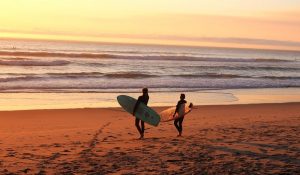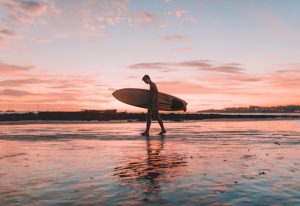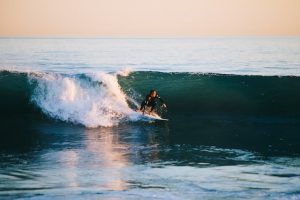We might as well face it…if fishing is called “fishing” and not “catching,” so too should surfing go by a different name? It should really be called “paddling” because we spend much more time lying prone on our boards stroking out to the lineup and then scratching into waves than actually riding them. So it would make sense that to be a good surfer you must by logic be a good paddler.
Let’s take a look at some techniques and tips you can use to improve your paddling so that you get more quality time riding waves.
The Best Paddle Techniques
Every surfer eventually evolves his/her own personal paddling style that works most effectively. The only problem is that some paddle techniques can shred both your back and shoulders after years of constant use. That said, let’s look at some easy ways to get the most power from the least effort.
Find the sweet spot on your board. Inexperienced surfers often lie too far back as they paddle, which will lift the nose and cause the board to push water. This makes it difficult to get any momentum and thus almost impossible to catch waves. Conversely, lying too far forward will cause your board to nose dive, which I’m sure you can conclude is equally ineffective when it comes to paddling.
It’s key that you think about your placement on the board. Like all of surfing, it’s a balancing act. Think about the core of your body and weight. You should be equally centered on your board so that your shoulders, legs, and head are all even above the water and your center is keeping the board connected to the water.
Stay loose and relax. If you stay tensed up, hold your head up, and constantly kick your legs; you will eventually blow an O-ring. Remember that paddling, while a relentless pursuit during your session, needs to be a time for you to recover from your last ride.
The worst thing you can do is get back to the lineup out of breath, physically spent, and unable to stroke into a set when the opportunity presents itself. So just chill…slow and steady wins the race. Lower your head, even rest your chin on your board and approach your paddling as a time to contemplate. Breathe through your nose and keep calm.
Engage your whole body As I stated earlier, you can shred certain muscles and tendons from repetitive movements like paddling. One way to avoid this is to engage all your muscles so that they are all working as a team. Think about your muscles as you paddle, and you will use them. The power should be coming from a concerted effort of your back, chest, stomach, and shoulders. The movements should be smooth and long, not quick and jerky. Concentrate on long pulls that use your whole body and create a constant speed.
Stoke out your stroke. Do not spaz out. Take long, smooth strokes that extend and go deep. Let them smoothly complete their rotations that enter and exit the water without excessive splashing and turbulence. Depending on the immediate purpose, you can change your intensity. For wide open spaces, use long, smooth strokes with your head down.
When accelerating to catch a wave, you might want to lift your head and neck to get a view of the developing wall and to look for other surfers, but once you are engaged in a wave, put your chin on the board and dig deep and feel the pull of the water. Here it might be effective to add a kick with your feet. Think about your freestyle swim stroke and realize that your kicking feet give you a constant jet blast that off-sets your arms’ efforts, and the same logic holds true, especially when you really want that wave.
Go rip already!



